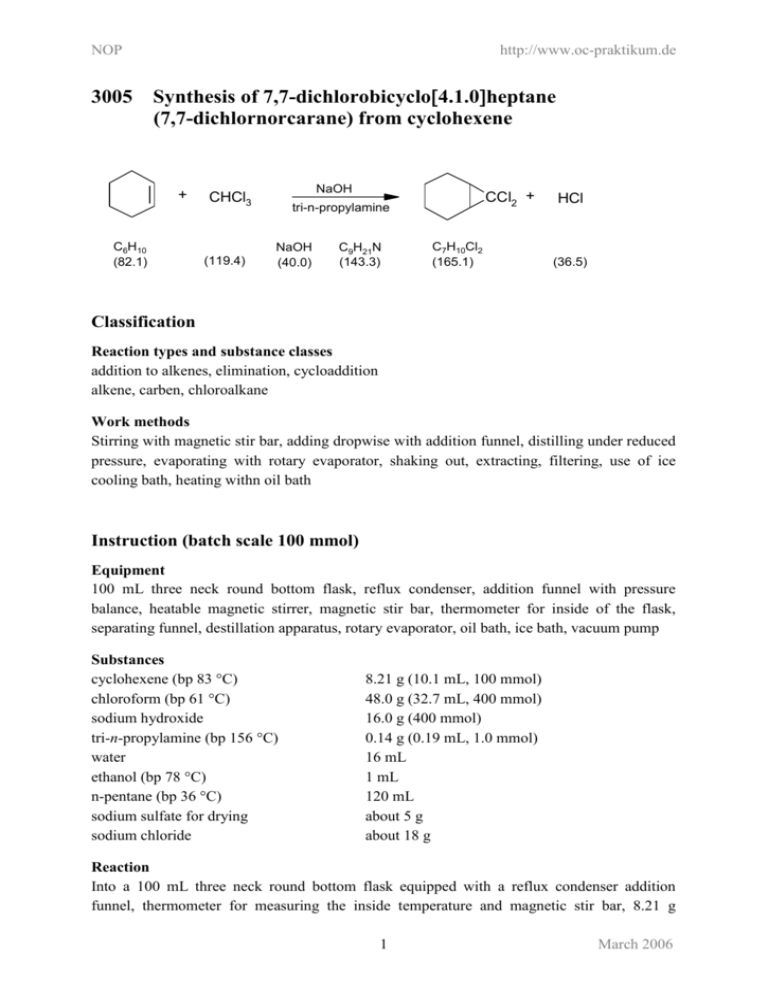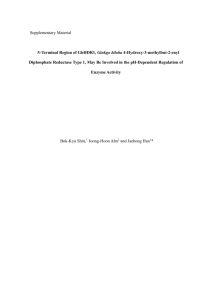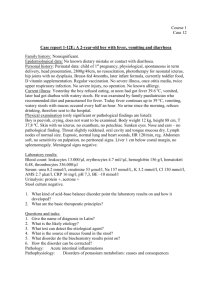349 - kriemhild
advertisement

NOP http://www.oc-praktikum.de 3005 Synthesis of 7,7-dichlorobicyclo4.1.0heptane (7,7-dichlornorcarane) from cyclohexene + C6H10 (82.1) NaOH CHCl3 (119.4) CCl2 + tri-n-propylamine NaOH (40.0) C9H21N (143.3) C7H10Cl2 (165.1) HCl (36.5) Classification Reaction types and substance classes addition to alkenes, elimination, cycloaddition alkene, carben, chloroalkane Work methods Stirring with magnetic stir bar, adding dropwise with addition funnel, distilling under reduced pressure, evaporating with rotary evaporator, shaking out, extracting, filtering, use of ice cooling bath, heating withn oil bath Instruction (batch scale 100 mmol) Equipment 100 mL three neck round bottom flask, reflux condenser, addition funnel with pressure balance, heatable magnetic stirrer, magnetic stir bar, thermometer for inside of the flask, separating funnel, destillation apparatus, rotary evaporator, oil bath, ice bath, vacuum pump Substances cyclohexene (bp 83 °C) chloroform (bp 61 °C) sodium hydroxide tri-n-propylamine (bp 156 °C) water ethanol (bp 78 °C) n-pentane (bp 36 °C) sodium sulfate for drying sodium chloride 8.21 g (10.1 mL, 100 mmol) 48.0 g (32.7 mL, 400 mmol) 16.0 g (400 mmol) 0.14 g (0.19 mL, 1.0 mmol) 16 mL 1 mL 120 mL about 5 g about 18 g Reaction Into a 100 mL three neck round bottom flask equipped with a reflux condenser addition funnel, thermometer for measuring the inside temperature and magnetic stir bar, 8.21 g 1 March 2006 NOP http://www.oc-praktikum.de (10.1 mL, 100 mmol) cyclohexene 0.14 g (0.19 mL, 1.0 mmol) tri-n-propylamine, 48.0 g (32.7 mL, 400 mmol) chloroform and 1 mL ethanol is added. The mixture is cooled to 0 °C with an ice bath, then under stirring and further cooling in the ice bath a solution of 16.0 g (400 mmol) sodium hydroxide in 16 mL water is added through an addition funnel. The mixture should be stirred vigourously during the next 20 minutes at 0 °C. After this time the mixture is further stirred during 1 hour at room temperature and 3 hours at 50 °C. Work up Chloroform is evaporated with a rotary evaporator, then the residue is transferred with about 50 mL water and 30 mL n-pentane into a separating funnel. The organic phase is separated, the aqueous phase is further extracted three times with 30 mL pentane. If an emulsion is formed the aqueous phase is saturated with NaCl. The combined organic phases are dried over sodium sulfate. The solution is filtered from sodium sulfate and the solvent is evaporated with a rotary evaporator, yielding a nearly colourless liquid as crude product. The crude yield is 14.6 g. The crude product is distilled under reduced pressure. Yield: 13.6 g (82.3 mmol, 82%), colourless liquid; bp 77 °C (11 hPa) Waste management Waste disposal Waste evaporated chloroform (may contain some cyclohexene) evaporated n-pentane (may contain some chloroform aqueous phase, after extraction destillation residue sodium sulfate Disposal organic solvents, containing halogen organic solvents, containing halogen solvent water mixtures, containing halogen organic solvents, containing halogen solid waste, free from mercury Time 6 hours Break Before work up Degree of difficulty Easy Instruction (batch scale 10 mmol) Equipment 100 mL three neck round bottom flask, reflux condenser, addition funnel with pressure balance, heatable magnetic stirrer, magnetic stir bar, thermometer for inside of the flask, separating funnel, destillation apparatus, rotary evaporator, oil bath, ice bath, vacuum pump 2 March 2006 NOP Substances cyclohexene (bp 83 °C) chloroform (bp 61 °C) sodium hydroxide tri-n-propylamine (bp 156 °C) water ethanol (bp 78 °C) n-pentane (bp 36 °C) sodium sulfate for drying sodium chloride http://www.oc-praktikum.de 0.821 g (1.01 mL, 10.0 mmol) 7.5 g (5.0 mL, 62 mmol) 1.60 g (40.0 mmol) 0.014 g (0.02 mL, 0.10 mmol) 1.6 mL 0.1 mL 65 mL about 1 g about 2 g Reaction Into a 10 mL three neck round bottom flask equipped with a reflux condenser addition funnel, thermometer for measuring the inside temperature and magnetic stirring bar, 0.82 g (1.01 mL, 100 mmol) cyclohexene 0.014 g (0.019 mL, 0.1 mmol) tri-n-propylamine, 4.8 g (0.5 mL, 62 mmol) chloroform and 0.1 mL ethanol is added. The mixture is cooled to 0 °C with an ice bath, then under stirring and further cooling of the ice bath a solution of 1.6 g (40.0 mmol) sodium hydroxide in 1.6 mL water is added by a addition funnel. The mixture should be stirred vigourously during the next 20 minutes at 0 °C. After this time the mixture is further stirred during 1 hour at room temperature and 3 hours at 50 °C. Work up Chloroform is evaporated with a rotary evaporator, then the residue is transferred with about 5 mL water and 5 mL n-pentane into a separating funnel. The organic phase is separated, the aqueous phase is further extracted three times with 20 mL pentane. If an emulsion is formed the aqueous phase is saturated with NaCl. The combined organic phases are dried over sodium sulfate. The solution is filtered from sodium sulfate and the solvent is evaporated with a rotary evaporator, yielding a nearly colourless liquid as crude product. The crude yield is 1.4 g. The crude product is distilled under reduced pressure. Yield 1.3 g (8.2 mmol, 82%), colourless liquid; bp 77 °C (11 hPa) Waste management Waste disposal Waste evaporated chloroform (may contain some cyclohexene) evaporated n-pentane (may contain some chloroform aqueous phase, after extraction destillation residue sodium sulfate Disposal organic solvents, containing halogen organic solvents, containing halogen solvent water mixtures, containing halogen organic solvents, containing halogen solid waste, free from mercury 3 March 2006 NOP http://www.oc-praktikum.de Time 6 hours Break Before work up Degree of difficulty Easy Instruction (batch scale 1 mol) Equipment 100 mL three neck round bottom flask, reflux condenser, addition funnel with pressure balance, heatable magnetic stirrer, magnetic stir bar, thermometer for inside of the flask, separating funnel, destillation apparatus, rotary evaporator, oil bath, ice bath, vacuum pump Substances cyclohexene (bp 83 °C) chloroform (bp 61 °C) sodium hydroxide tri-n-propylamine (bp 156 °C) water ethanol (bp 78 °C) n-pentane (bp 36 °C) sodium sulfate for drying sodium chloride 82.1 g (101 mL, 1.00 mol) 480 g (327 mL, 4.00mol) 160 g (4.00 mol) 1.4 g (1.9 mL, 10 mmol) 160 mL 10 mL 600 mL about 5 g about 35g Reaction Into a 1000 mL three neck round bottom flask equipped with a reflux condenser addition funnel, thermometer for measuring the inside temperature and magnetic stir bar, 82.1 g (10.1 mL, 4 mol) cyclohexene 1.4 g (1.9 mL, 10 mmol) tri-n-propylamine, 480 g (327 mL, 400 mmol) chloroform and 10 mL ethanol is added. The mixture is cooled to 0 °C with an ice bath, then under stirring and further cooling of the ice bath a solution of 160 g (4mol) sodium hydroxide dissolved in 160 mL water is added by a addition funnel. The mixture should be stirred vigourously during the next 20 minutes at 0 °C. After this time the mixture is further stirred during 1 hour at room temperature and 3 hours at 50 °C. Work up Chloroform is evaporated with a rotary evaporator, then the residue is transferred with about 100 mL water and 150 mL n-pentane into a separating funnel. The organic phase is separated, the aqueous phase is further extracted three times with 150 mL pentane. If an emulsion is formed the aqueous phase is saturated with sodium chloride. The combined organic phases are dried over sodium sulfate. The solution is filtered from sodium sulfate and the solvent is 4 March 2006 NOP http://www.oc-praktikum.de evaporated with a rotary evaporator, yielding a nearly colourless liquid as crude product. The crude yield is 151.0 g.The crude product is distilled under reduced pressure. Yield: 139 g (0.842 mol, 84%), colourless liquid; bp 77 °C (11 hPa) Waste management Waste disposal Waste evaporated chloroform (may contain some cyclohexene) evaporated n-pentane (may contain some chloroform aqueous phase, after extraction destillation residue sodium sulfate Disposal organic solvents, containing halogen organic solvents, containing halogen solvent water mixtures, containing halogen organic solvents, containing halogen solid waste, free from mercury Time 6 hours Break Before work up Degree of difficulty Easy Analytics GC Sample preparation: One drop of the compound is dissolved in 1 mL tert-butyl methyl ether, 1 µL is injected. GC conditions: column: inlet: carrier gas: oven: detector: Macherey und Nagel, SE-54, 326-MN-30705-9, 25 m, ID 0.32 mm, DF 0.25 µm Gerstel KAS, injector 250 °C; split injection: 1:20, injected volume 1 µL nitrogen, pre-column pressure 62 kPa, flow rate 1.04 mL/min 80 °C (1 min), 10 °C/min (250 °C) (30 min) FID, 275 °C Percent concentration was calculated from peak areas. 5 March 2006 NOP http://www.oc-praktikum.de GC of the crude product Retention time (min) 8.2 2.7 Substance 7,7-dichloronorcarane not identified Peak area % 98 2 Substance 7,7-dichloronorcarane Peak area % > 99 GC of the pure product Retention time (min) 8.2 6 March 2006 NOP 1H http://www.oc-praktikum.de NMR spectrum of the crude product (500 MHz, CDCl3) 9 1H 8 7 6 5 4 3 2 1 0 2 1 0 NMR spectrum of the pure product (500 MHz, CDCl3) 9 (ppm) 1.12 - 1.36 1.61 - 1.71 1.88 - 1.98 7.26 8 7 Multiplicity m m m 6 5 4 Number of H 4 4 2 7 3 Assignment 3-H, 4-H 2-H, 5-H 1-H, 6-H solvent 5 4 6 CCl2 3 2 1 7 March 2006 NOP 13C NMR spectrum of the crude product (125 MHz, CDCl3) 120 13C http://www.oc-praktikum.de 110 100 90 80 70 60 50 40 30 20 10 0 20 10 0 NMR spectrum of the purified product (125 MHz, CDCl3) 120 110 100 (ppm) 18.9 20.2 25.8 67.4 76.5-77.5 90 80 70 60 50 Assignment C-3, C-4 C-2, C-5 C-1, C-6 C-7 solvent 40 30 5 4 6 CCl2 3 1 7 2 8 March 2006 NOP http://www.oc-praktikum.de IR spectrum of the crude product (film) IR spectrum of pure product (film) (cm-1) 2944, 2859 796 Assignment C-H-valence, alkane C-Cl-valence 9 March 2006






